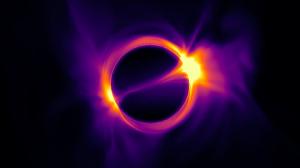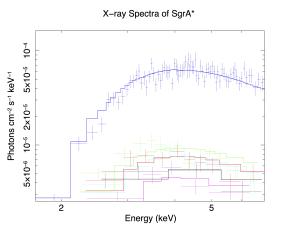Blog
Spin Doctor
26 October 2023
 Chris White, Princeton University
Chris White, Princeton UniversityPick any object in the Universe, and it is probably spinning. Asteroids tumble end over end, planets and moons rotate on their axes, and even black holes spin. And for everything that spins, there is a maximum rate at which it can rotate. The black hole in our galaxy is spinning at nearly that maximum rate.1
For objects such as the Earth, the maximum rate of rotation is defined by its surface gravity. The weight we feel while standing on the Earth isn’t just due to the gravitational pull of the Earth. Gravity pulls us toward the center of our world, but the Earth’s rotation also tends to fling us outward away from the Earth. This “centrifugal” force is tiny, but it does mean that your weight at the equator is just slightly less than it is at the north or south pole.
With our 24-hour day, the weight difference between the equator and pole is just 0.3%. But Saturn’s 10-hour day means that the difference is 19%. So much that Saturn bows outward a bit at its equator. Now imagine a planet spinning so fast that the difference was 100%. At that point, the gravitational pull of the planet and its centrifugal force at the equator would cancel out. If the world were to spin any faster. it would fly apart. It would likely fly apart at an even slower spin rate, but this is clearly the maximum rate of rotation.
For black holes, things are a bit different. Black holes aren’t objects with a physical surface. They aren’t made of material that could fly apart. But they still have a maximum rate of rotation. Black holes are defined by their tremendous gravity, which distorts space and time around them. The event horizon of the black hole marks the point of no return for nearby objects, but it isn’t a physical surface.
 Daly, et al
Daly, et alThe rotation of a black hole also isn’t defined by the spin of physical mass, but rather by the twisting of spacetime around the black hole. When objects such as the Earth spin, they twist space around themselves very slightly. It’s an effect known as frame dragging. The spin of a black hole is defined by this frame-dragging effect. Black holes spin without the physical rotation of matter, just a twisted spacetime structure. This means there is an upper limit to this spin due to the inherent properties of space and time. In Einstein’s equations of general relativity, the spin of a black hole is measured by a quantity known as a, where a has to be between zero and one. If a black hole has no spin, then a = 0, and if it is at its maximal rotation, then a = 1.
This brings us to a new study on the rotation of the supermassive black hole in our galaxy. The team looked at radio and X-ray observations of the black hole to estimate its spin. Due to the frame-dragging of spacetime near the black hole, the spectra of light from material near it is distorted. By observing the intensity of light at various wavelengths, the team was able to estimate the amount of spin. What they found was that the a value for our black hole is between 0.84 and 0.96, which means it’s rotating incredibly fast. At the upper range of the estimated rotation, it would be rotating at nearly the maximal rate. This is even higher than the spin parameter of the black hole in M87, where a is estimated to be between 0.89 and 0.91.
Daly, Ruth A., et al. “New Black Hole Spin Values for Sagittarius A* Obtained with the Outflow Method.” Monthly Notices of the Royal Astronomical Society (2023): stad3228. ↩︎